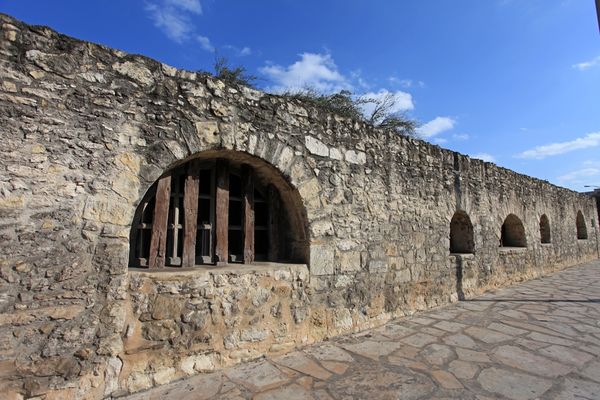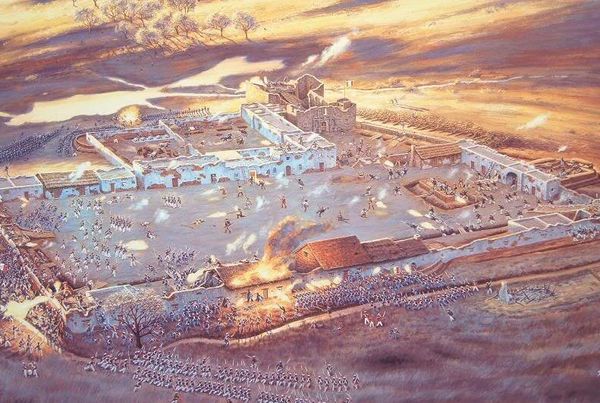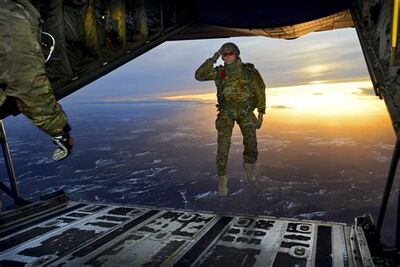According to Trump--a Wall saved San Antonio
Aug 20, 2019 00:57:07 #
Aug 20, 2019 07:39:59 #
PeterS wrote:
How would you like the job of Donald Trumps Fact Checker???
His i***ts will buy it and that is all that matters to him.
Aug 20, 2019 08:35:44 #
lpnmajor
Loc: Arkansas
PeterS wrote:
How would you like the job of Donald Trumps Fact Checker???
He meant the Alamo.
Aug 20, 2019 15:43:59 #
Boo_Boo
Loc: Jellystone
The Alamo (meaning cottonwood (the trees which some still grow in the courtyard)) did/does have a wall. It was due to this wall that 180 men withstood the forces of thousands.
This battle is interesting for the brief standoff, lasting only 13 days, which the Texans physically lost, while winning respect of Mexicans and the hearts of Americans (and many European nations). A battle cry that is still on the Texas state f**g...remember the Alamo! It is also important in the history of Mexico and of course for Texas who would become a highly controversial ingredient in the War of Northern Aggression.
The battle at the Alamo was more than the 13 days. Those last days were actually part of events that changed the maps and leadership of 3 nations; Spain, Mexico, and America. Napoleon Bonaparte invaded Spain, and after six years the Spanish resistance ousted the French emperor and restored Ferdinand VII to the throne. This fired up Mexico who wanted to become independent from Spain...a very bad decision on their part....but, Father Miguel Hidalgo rang the bells of his small church in Dolores at midnight on September 15, 1810, to herald the beginning of the second revolution. This Mexican revolt against Spanish occupation traveled quickly across Mexico and into the northern frontier of the Mexican territory of Texas. San Antonio de Béxar, the capital of Texas, became a center of revolutionary activity and a haven for resistance fighters. One revolutionary, Captain Jose Menchaca, was captured by Spanish troops, shot and beheaded. His head was then stuck on a pole in front of the Alamo. Instead of setting an example for the other insurgents, however, Menchaca’s execution only added fuel to the revolt. Eleven long years later Mexico gained its freedom, but at a cost. Agustin de Iturbide, a Spanish general turned rebel and a hero of the revolution, became emperor of the new nation. And he behaved badly, quickly emptying the banks and reserves of Mexico to support his lifestyle. He also, due to his greed, started selling out Texas to American colonists, but those individuals had to convert, help support (which Iturbide received kickbacks) the Catholic Church. It is important for you, the reader, to remember why many colonists left England....freedom from imposed religion. In no time a revolt led by General Antonio López de Santa Anna brought about Iturbide’s downfall and established a Mexican republic.
There is so much more to this story....but, bottom line, those 13 days allowed Texas to sever ties with Mexico.
This battle is interesting for the brief standoff, lasting only 13 days, which the Texans physically lost, while winning respect of Mexicans and the hearts of Americans (and many European nations). A battle cry that is still on the Texas state f**g...remember the Alamo! It is also important in the history of Mexico and of course for Texas who would become a highly controversial ingredient in the War of Northern Aggression.
The battle at the Alamo was more than the 13 days. Those last days were actually part of events that changed the maps and leadership of 3 nations; Spain, Mexico, and America. Napoleon Bonaparte invaded Spain, and after six years the Spanish resistance ousted the French emperor and restored Ferdinand VII to the throne. This fired up Mexico who wanted to become independent from Spain...a very bad decision on their part....but, Father Miguel Hidalgo rang the bells of his small church in Dolores at midnight on September 15, 1810, to herald the beginning of the second revolution. This Mexican revolt against Spanish occupation traveled quickly across Mexico and into the northern frontier of the Mexican territory of Texas. San Antonio de Béxar, the capital of Texas, became a center of revolutionary activity and a haven for resistance fighters. One revolutionary, Captain Jose Menchaca, was captured by Spanish troops, shot and beheaded. His head was then stuck on a pole in front of the Alamo. Instead of setting an example for the other insurgents, however, Menchaca’s execution only added fuel to the revolt. Eleven long years later Mexico gained its freedom, but at a cost. Agustin de Iturbide, a Spanish general turned rebel and a hero of the revolution, became emperor of the new nation. And he behaved badly, quickly emptying the banks and reserves of Mexico to support his lifestyle. He also, due to his greed, started selling out Texas to American colonists, but those individuals had to convert, help support (which Iturbide received kickbacks) the Catholic Church. It is important for you, the reader, to remember why many colonists left England....freedom from imposed religion. In no time a revolt led by General Antonio López de Santa Anna brought about Iturbide’s downfall and established a Mexican republic.
There is so much more to this story....but, bottom line, those 13 days allowed Texas to sever ties with Mexico.
Wall around the Alamo

Aug 21, 2019 17:11:30 #
Aug 21, 2019 17:15:14 #
PeterS wrote:
How would you like the job of Donald Trumps Fact Checker???
We know who the fact checkers are and we know what is their agenda. So, DILLIGAF!
Aug 21, 2019 17:26:30 #
Boo_Boo
Loc: Jellystone
Hug wrote:
Great Post!
Thank you.....I wish I had gone more into that 13 days because it was the birth of Texas. And that birth ushered us into the War of Northern Aggression....pieces of the puzzle on how we as a nation divided and has never blended as one nation.
Aug 22, 2019 00:13:27 #
Aug 22, 2019 00:16:49 #
Pennylynn wrote:
The Alamo (meaning cottonwood (the trees which som... (show quote)
So what you are saying that we need to build the wall because, even if we lose, we will win the hearts of Americans and many European nations? Got it...
Aug 22, 2019 00:36:38 #
Pennylynn wrote:
Thank you.....I wish I had gone more into that 13 days because it was the birth of Texas. And that birth ushered us into the War of Northern Aggression....pieces of the puzzle on how we as a nation divided and has never blended as one nation.
The war of Northern Aggression? Gosh, Miss Penny, that would make you one of them Conservative Democrats of yesteryear that today's Republican party likes to blame for the formation of the KKK, Jim Crow, and the suppression of all minorities up to this very day. Well, nice to meetcha. With folks like you around it's easy to see why we never blinded as one nation. Gaday.
Aug 22, 2019 00:39:49 #
Blade_Runner wrote:
We know who the fact checkers are and we know what is their agenda. So, DILLIGAF!
Excuse me. If that's the size and type of wall that will keep Mexican's out and us Americans safe go to Pelosi and I will bet she approves it in under a day...
Aug 22, 2019 00:49:36 #
Boo_Boo
Loc: Jellystone
To the People of Texas and All Americans in the World….I shall never surrender or retreat….Victory or Death!
So, as you know the battle at the Alamo was a turning point for Texas and Mexico. Do you want the rest of the story?? Read on
The Republic of Mexico, was born impoverished and unprepared for self governorship, would have 13 “Presidents” in the first 15 years of “Independence.” Each struggled for power, shifting between the liberal-leaning Federalists and the dictatorial Centralists. The first president, a hero of the revolution, was a Liberal Federalist, General Guadalupe Victoria, and he gave, in 1824, Mexico a liberal Constitution. This infuriated Santa Anna and that would lead to the Battle of the Alamo 12 years later.
While Mexico brawled for control of Mexico’s presidency, the northern territory was neglected. When Mexico redefined its territories in 1824, Texas was the only separate territory to lose its independence. Over the objections of its citizens, the capitol was moved from Texas, San Antonio de Béxar to Coahuila, Saltillo. In September 1835, the citizens of Texas petitioned for statehood separate from Coahuila. They wrote out their needs and their complaints in The Declaration of Causes. This document was designed to convince the Federalists that the Texans desired only to preserve the 1824 Constitution, which guaranteed the rights of everyone living on Mexican soil. But by this time, Santa Anna was in power, having seized control in 1833, and he advocated the removal of all foreigners. His answer was to send his crack troops, commanded by his brother-in-law, General Martín Perfecto de Cós, to San Antonio to disarm the Texans.
October 1835 found San Antonio de Béxar under military rule, with 1,200 Mexican troops under General Cós’ command. When Cós ordered the small community of Gonzales, about 50 miles east of San Antonio, to return a cannon loaned to the town for defense against Indian attack–rightfully fearing that the citizens might use the cannon against his own troops–the Gonzales residents refused. Come and take it! they taunted, setting off a charge of old chains and scrap iron, shot from the mouth of the tiny cannon mounted on ox-cart wheels. Although the only casualty was one Mexican soldier, Gonzales became enshrined in history as the Lexington of Texas. The Texas Revolution was on.
On December 5, fighting in Béxar raged with a house-to-house assault unlike anything the Mexican army had ever before experienced. Cós finally flew the white f**g of surrender from the Alamo on December 9. More than 200 of his men lay dead, and as many more were wounded. He signed papers of capitulation, giving the Texans all public property, money, arms and ammunition in San Antonio, and by Christmas Day, the Mexican army was back across the Rio Grande. To the Texans, who lost about 20 men, the victory seemed cheap and easy.
The siege of Béxar and Cós’ surrender brought immediate retaliation from Santa Anna. He whipped together a force of 8,000 men, many of them foreign adventurers from Europe and America. One of his deadliest snipers was an Illinois man named Johnson! Santa Anna, the self-styled Napoleon of the West, marched at the head of the massive army; he was determined to stamp out all opposition and teach the Texans a lesson. The word went out to his generals: In this war, you understand, there are no prisoners.
It was midwinter, Santa Anna pushed his army mercilessly toward Texas. The frigid, wind-battered deserts of northern Mexico took their toll. Men and animals died by the hundreds and were left on the trail, and the brigades strung out for uncounted miles. When the big siege guns bogged down in one of the many quagmires, Santa Anna pushed on without them. Nothing would stop him. Meanwhile, after the defeated Mexican force under General Cós had left San Antonio, Colonel James C. Neill had assumed command of the Alamo garrison, which consisted of about 80 poorly equipped men in several small companies, including the volunteers. The rest of the soldiers had returned home to their families and farm chores. In this command were an artillery company under Captain William R. Carey known as the Invincibles, two small infantry companies known as the New Orleans Greys under Captain William Blazeby, and the Béxar Guards under Captain Robert White.
On January 17, 1836, Sam Houston, the commander of the revolutionary troops, sent Colonel Jim Bowie and 25 men to San Antonio with orders to destroy the Alamo fortifications and retire eastward with the artillery. But Bowie and Neill agreed that it would be impossible to remove the 24 captured cannons without oxen, mules or horses. And they deemed it foolhardy to abandon that much firepower–by far the most concentrated at any location during the Texas Revolution. Bowie also had a keen eye for logistics, terrain, and avenues of assault. Knowing that General Houston needed time to raise a sizable army to repel Santa Anna, Bowie set about reinforcing the Alamo after Neill was forced to leave because of sickness in his family.
Colonel William Travis arrived in San Antonio on February 2 with a small cavalry company, bringing the total number of Alamo defenders to about 130. Although spies told him that Santa Anna had crossed the Rio Grande, Travis did not expect the dictator before early spring. He sent letter after letter, pleading for supplies and more men. He and Bowie also competed for command of the garrison before it was decided that Bowie would command the volunteers and Travis the regular army. On February 9, David Crockett and the 14 other Tennessee Mounted Volunteers rode into San Antonio. Alarmed by the Mexican army on the outskirts of town, Travis vigorously renewed his pleas for help. His February 24 letter, To the People of Texas and All Americans in the World….I shall never surrender or retreat….Victory or Death! is considered one of the most heart-wrenching pleas ever written. Travis sent the message out with Captain Albert Martin.
The day before, February 23, Santa Anna had reclaimed San Antonio. To the triumphant music of a military band, he took possession of the town, set up headquarters on the main plaza, and began the siege. He had his standard-bearers climb to the top of the bell tower of San Fernando Church and unfurl the scarlet f**g of no quarter. Inside the Alamo, Travis and the Texans fired their message to Santa Anna with a blast from their 18-pounder. They had their music, too, with Davy Crockett’s fiddle and John McGregor’s bagpipes. In fact, Davy’s fiddle-playing and outlandish storytelling kept up the spirits of the besieged defenders.
Santa Anna ordered his men to pound the fortifications with cannon and rifle fire for 12 days and nights. His idea was to wear out the defenders inside, giving them no chance for rest or sleep. He reasoned that a weary army would be an easy one to defeat. But the noise worked on his own army, too. Unable to hear clearly through the din, they allowed courier after courier to escape from the Alamo. On March 2, racing through the enemy’s lines, the last group to reinforce the Alamo arrived. These men were the relief force from Gonzales, the only town to answer Travis’ pleas to send help. The total number of Alamo defenders now stood at between 180 and 190.
At 4 o’clock on the morning of March 6, 1836, Santa Anna advanced his men to within 200 yards of the Alamo’s walls. Just as dawn was breaking, the Mexican bloodcurdling bugle call of the Deguello echoed the meaning of the scarlet f**g above San Fernando: no quarter. It was Captain Juan Seguin’s Tejanos, the native-born Mexicans fighting in the Texan army, who interpreted the chilling music for the other defenders.
Santa Anna’s first charge was repulsed, as was the second, by the deadly fire of Travis’ artillery. At the third charge, one Mexican column attacked near a breach in the north wall, another in the area of the chapel, and a third, the Toluca Battalion, commenced to scale the walls. All suffered severely. Out of 800 men in the Toluca Battalion, only 130 were left alive. Fighting was hand to hand with knives, pistols, clubbed rifles, lances, pikes, knees and fists. The dead lay everywhere. Blood spilled in the convent, the barracks, the entrance to the church, and finally in the rubble-strewn church interior itself. Ninety minutes after it began, it was over.
All the Texans died. Santa Anna’s loss was 1,544 men. More than 500 Mexicans lay wounded, their groans mingling with the haunting strains of the distant bugle calls. Santa Anna airily dismissed the Alamo conquest as a small affair, but one of his officers commented, Another such victory will ruin us.
As many of the Mexican dead as possible were given the rites of the church and buried, but there were so many that there was not sufficient room in the cemetery. Santa Anna ordered all the bodies of the Texans to be contemptuously stacked like cord wood in three heaps, mixed with fuel, wood and dry branches from the neighboring forest, and set on fire–except one. Jose Gregorio Esparza was given a Christian burial because his brother Francisco was a member of General Cós’ presidio guards.
Six weeks after the Alamo, while the Mexican wounded still languished in San Antonio, Santa Anna met his Waterloo at San Jacinto. The men who died inside the walls of the Alamo had bought with their lives the time needed for General Sam Houston to weld a force that won Texas its independence. The great sacrifice would not be forgotten by history, nor would the Alamo’s many legends and stories, most of which can never be proved or disproved because all the defenders died.
So, as you know the battle at the Alamo was a turning point for Texas and Mexico. Do you want the rest of the story?? Read on
The Republic of Mexico, was born impoverished and unprepared for self governorship, would have 13 “Presidents” in the first 15 years of “Independence.” Each struggled for power, shifting between the liberal-leaning Federalists and the dictatorial Centralists. The first president, a hero of the revolution, was a Liberal Federalist, General Guadalupe Victoria, and he gave, in 1824, Mexico a liberal Constitution. This infuriated Santa Anna and that would lead to the Battle of the Alamo 12 years later.
While Mexico brawled for control of Mexico’s presidency, the northern territory was neglected. When Mexico redefined its territories in 1824, Texas was the only separate territory to lose its independence. Over the objections of its citizens, the capitol was moved from Texas, San Antonio de Béxar to Coahuila, Saltillo. In September 1835, the citizens of Texas petitioned for statehood separate from Coahuila. They wrote out their needs and their complaints in The Declaration of Causes. This document was designed to convince the Federalists that the Texans desired only to preserve the 1824 Constitution, which guaranteed the rights of everyone living on Mexican soil. But by this time, Santa Anna was in power, having seized control in 1833, and he advocated the removal of all foreigners. His answer was to send his crack troops, commanded by his brother-in-law, General Martín Perfecto de Cós, to San Antonio to disarm the Texans.
October 1835 found San Antonio de Béxar under military rule, with 1,200 Mexican troops under General Cós’ command. When Cós ordered the small community of Gonzales, about 50 miles east of San Antonio, to return a cannon loaned to the town for defense against Indian attack–rightfully fearing that the citizens might use the cannon against his own troops–the Gonzales residents refused. Come and take it! they taunted, setting off a charge of old chains and scrap iron, shot from the mouth of the tiny cannon mounted on ox-cart wheels. Although the only casualty was one Mexican soldier, Gonzales became enshrined in history as the Lexington of Texas. The Texas Revolution was on.
On December 5, fighting in Béxar raged with a house-to-house assault unlike anything the Mexican army had ever before experienced. Cós finally flew the white f**g of surrender from the Alamo on December 9. More than 200 of his men lay dead, and as many more were wounded. He signed papers of capitulation, giving the Texans all public property, money, arms and ammunition in San Antonio, and by Christmas Day, the Mexican army was back across the Rio Grande. To the Texans, who lost about 20 men, the victory seemed cheap and easy.
The siege of Béxar and Cós’ surrender brought immediate retaliation from Santa Anna. He whipped together a force of 8,000 men, many of them foreign adventurers from Europe and America. One of his deadliest snipers was an Illinois man named Johnson! Santa Anna, the self-styled Napoleon of the West, marched at the head of the massive army; he was determined to stamp out all opposition and teach the Texans a lesson. The word went out to his generals: In this war, you understand, there are no prisoners.
It was midwinter, Santa Anna pushed his army mercilessly toward Texas. The frigid, wind-battered deserts of northern Mexico took their toll. Men and animals died by the hundreds and were left on the trail, and the brigades strung out for uncounted miles. When the big siege guns bogged down in one of the many quagmires, Santa Anna pushed on without them. Nothing would stop him. Meanwhile, after the defeated Mexican force under General Cós had left San Antonio, Colonel James C. Neill had assumed command of the Alamo garrison, which consisted of about 80 poorly equipped men in several small companies, including the volunteers. The rest of the soldiers had returned home to their families and farm chores. In this command were an artillery company under Captain William R. Carey known as the Invincibles, two small infantry companies known as the New Orleans Greys under Captain William Blazeby, and the Béxar Guards under Captain Robert White.
On January 17, 1836, Sam Houston, the commander of the revolutionary troops, sent Colonel Jim Bowie and 25 men to San Antonio with orders to destroy the Alamo fortifications and retire eastward with the artillery. But Bowie and Neill agreed that it would be impossible to remove the 24 captured cannons without oxen, mules or horses. And they deemed it foolhardy to abandon that much firepower–by far the most concentrated at any location during the Texas Revolution. Bowie also had a keen eye for logistics, terrain, and avenues of assault. Knowing that General Houston needed time to raise a sizable army to repel Santa Anna, Bowie set about reinforcing the Alamo after Neill was forced to leave because of sickness in his family.
Colonel William Travis arrived in San Antonio on February 2 with a small cavalry company, bringing the total number of Alamo defenders to about 130. Although spies told him that Santa Anna had crossed the Rio Grande, Travis did not expect the dictator before early spring. He sent letter after letter, pleading for supplies and more men. He and Bowie also competed for command of the garrison before it was decided that Bowie would command the volunteers and Travis the regular army. On February 9, David Crockett and the 14 other Tennessee Mounted Volunteers rode into San Antonio. Alarmed by the Mexican army on the outskirts of town, Travis vigorously renewed his pleas for help. His February 24 letter, To the People of Texas and All Americans in the World….I shall never surrender or retreat….Victory or Death! is considered one of the most heart-wrenching pleas ever written. Travis sent the message out with Captain Albert Martin.
The day before, February 23, Santa Anna had reclaimed San Antonio. To the triumphant music of a military band, he took possession of the town, set up headquarters on the main plaza, and began the siege. He had his standard-bearers climb to the top of the bell tower of San Fernando Church and unfurl the scarlet f**g of no quarter. Inside the Alamo, Travis and the Texans fired their message to Santa Anna with a blast from their 18-pounder. They had their music, too, with Davy Crockett’s fiddle and John McGregor’s bagpipes. In fact, Davy’s fiddle-playing and outlandish storytelling kept up the spirits of the besieged defenders.
Santa Anna ordered his men to pound the fortifications with cannon and rifle fire for 12 days and nights. His idea was to wear out the defenders inside, giving them no chance for rest or sleep. He reasoned that a weary army would be an easy one to defeat. But the noise worked on his own army, too. Unable to hear clearly through the din, they allowed courier after courier to escape from the Alamo. On March 2, racing through the enemy’s lines, the last group to reinforce the Alamo arrived. These men were the relief force from Gonzales, the only town to answer Travis’ pleas to send help. The total number of Alamo defenders now stood at between 180 and 190.
At 4 o’clock on the morning of March 6, 1836, Santa Anna advanced his men to within 200 yards of the Alamo’s walls. Just as dawn was breaking, the Mexican bloodcurdling bugle call of the Deguello echoed the meaning of the scarlet f**g above San Fernando: no quarter. It was Captain Juan Seguin’s Tejanos, the native-born Mexicans fighting in the Texan army, who interpreted the chilling music for the other defenders.
Santa Anna’s first charge was repulsed, as was the second, by the deadly fire of Travis’ artillery. At the third charge, one Mexican column attacked near a breach in the north wall, another in the area of the chapel, and a third, the Toluca Battalion, commenced to scale the walls. All suffered severely. Out of 800 men in the Toluca Battalion, only 130 were left alive. Fighting was hand to hand with knives, pistols, clubbed rifles, lances, pikes, knees and fists. The dead lay everywhere. Blood spilled in the convent, the barracks, the entrance to the church, and finally in the rubble-strewn church interior itself. Ninety minutes after it began, it was over.
All the Texans died. Santa Anna’s loss was 1,544 men. More than 500 Mexicans lay wounded, their groans mingling with the haunting strains of the distant bugle calls. Santa Anna airily dismissed the Alamo conquest as a small affair, but one of his officers commented, Another such victory will ruin us.
As many of the Mexican dead as possible were given the rites of the church and buried, but there were so many that there was not sufficient room in the cemetery. Santa Anna ordered all the bodies of the Texans to be contemptuously stacked like cord wood in three heaps, mixed with fuel, wood and dry branches from the neighboring forest, and set on fire–except one. Jose Gregorio Esparza was given a Christian burial because his brother Francisco was a member of General Cós’ presidio guards.
Six weeks after the Alamo, while the Mexican wounded still languished in San Antonio, Santa Anna met his Waterloo at San Jacinto. The men who died inside the walls of the Alamo had bought with their lives the time needed for General Sam Houston to weld a force that won Texas its independence. The great sacrifice would not be forgotten by history, nor would the Alamo’s many legends and stories, most of which can never be proved or disproved because all the defenders died.
Aug 22, 2019 02:01:58 #
Pennylynn wrote:
To the People of Texas and All Americans in the Wo... (show quote)
And like I said, if you think that size wall will keep out the Mexicans then I will send the spec's over to Pelosi myself and we will get the ball rolling~!
What would you say that is about a 2x8 with a 5-foot window every ten feet? We can probably cut down on the expense by putting in fewer windows but we will leave it like that for now and we will take out windows as part of the bargaining process...
Aug 22, 2019 02:39:55 #
Pennylynn wrote:
The Alamo (meaning cottonwood (the trees which som... (show quote)
Miss Penny, the wall that you are showing here is in the back of the church and maybe 100' x 100' and added well after the battle took place. The battle took place in the front of the church in what would be the plaza with Travis and Co. using the surrounding houses as barricades, or as Trump would say...a WALL, but the wall you are showing kept no one out not even the Mexicans. I take it you haven't seen the Alamo or the wall because if you had you would know that Santa Anna could have blown either apart with just one salvo from his cannon. By the time the battle got back to the Alamo most of the Americans were dead with Crocket being said the last to go.
But do keep regaling us about Walls they are very entertaining, just a bit overstated in this case...

Aug 22, 2019 02:46:46 #
Blade_Runner wrote:
We know who the fact checkers are and we know what is their agenda. So, DILLIGAF!
You know who the fact-checkers are? So you know that the wall Pennylynn showed was built around the back of the church and after the battle was over? You must since you know who the fact-checkers are--and we all know they certainly aren't YOU!
And you seem to be losing more and more of your ability to verbalize. So, DILLIGAF??? No doubt there was a fallacy in there someplace thus the reason for the shorthand...
If you want to reply, then register here. Registration is free and your account is created instantly, so you can post right away.



